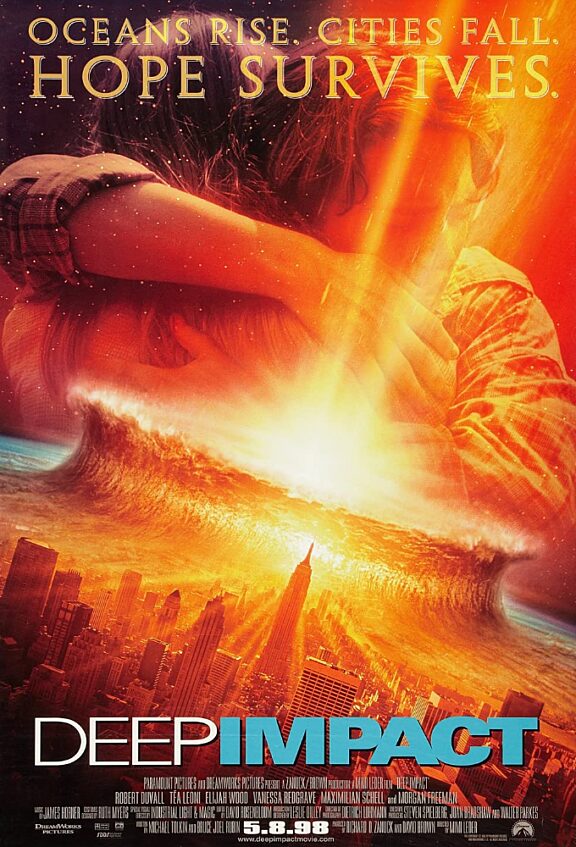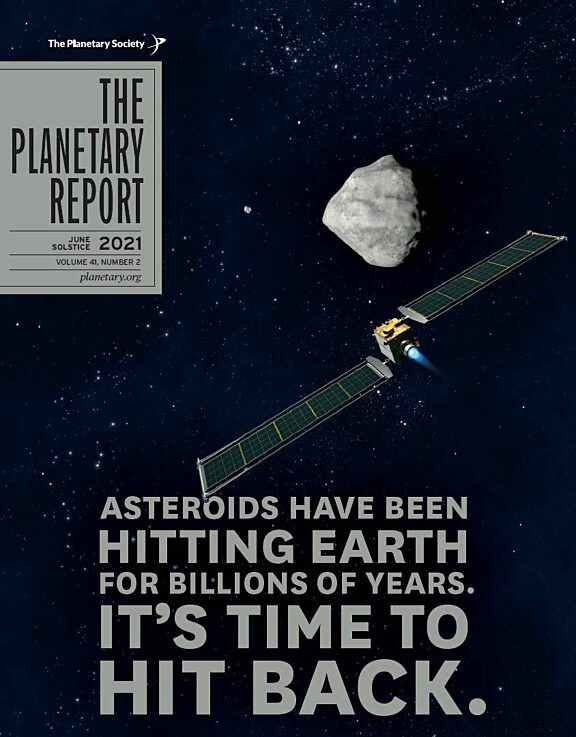"Just Nuke 'Em!" Planetary Defense in the Movies

Written by
Kate Howells
Public Education Specialist, The Planetary Society
June 14, 2021
The threat of asteroids or comets is something most people have only seen in movies. To get a sense of the public’s potential misconceptions about planetary defense, we’re taking a look at the two most iconic films in the deadly-rocks-from-space genre: Armageddon and Deep Impact. Here’s what they got right, what they got wrong, and why it matters.
Armageddon
In Armageddon, an asteroid the size of Texas is detected only 18 days away from a collision with Earth. NASA’s solution is to send a team of experienced oil drillers to land on the asteroid, drill a deep hole, plant nuclear bombs inside it, and blast it into two halves that will pass safely on either side of Earth. Much drama ensues, but eventually, they succeed at blowing the asteroid in two, vaporizing every smaller asteroid that was traveling with it, and returning safely to Earth (minus a few heroic casualties).

WHAT IT GOT RIGHT
Basically, the only things Armageddon got right are that it’s possible for an asteroid to hit Earth and that what looks like a single asteroid may actually be a group of asteroids bound together gravitationally.
WHAT IT GOT WRONG
So, so much. The movie confuses asteroids, comets, and meteors. The Russian Mir space station conveniently has artificial gravity. One character gets “space dementia.” The list goes on. But in terms of depicting planetary defense, these aren’t the most important inaccuracies.
The main problem is that the timing of the events depicted is extraordinarily unrealistic. The asteroid is detected only 18 days from impact, and within that time frame, NASA is able to precisely determine its composition, map its surface, calculate exactly how much force would be needed to split it neatly in half with neither half impacting Earth, train oil drillers to operate in space, send spacecraft to intercept the asteroid, and blow it up.
Deep Impact
In Deep Impact, a comet the size of New York City is on a
trajectory to impact Earth in two years. After a year spent developing a
plan and building an enormous spacecraft in collaboration with Russia,
the U.S. government informs the public and other world governments. The
plan is familiar: plant a nuke inside the comet to blow it apart.
The plan to nuke the comet fails, only splitting a smaller chunk off the main comet. Plan B (exploding nuclear warheads next to the comet to change its course) also fails. People start rioting and looting in desperation. The secondary chunk of comet strikes the Atlantic Ocean, creating tsunamis that kill millions. At the last moment, NASA astronauts manage to blow up the main comet, and an extinction-level impact is averted.

WHAT IT GOT RIGHT
Deep Impact is a breath of fresh air next to Armageddon, and if you only watch one, we recommend this one. The timescale is slightly more believable, and the technologies depicted make a bit more sense. It also acknowledges that blowing up a comet would create debris that could still impact Earth. Deep Impact also gets points for addressing the fact that society would probably have a less than peaceful reaction to impending doom.
WHAT IT GOT WRONG
Although it too is riddled with minor inaccuracies, Deep Impact’s main shortcoming is that the U.S. government manages to keep the comet a secret for a year, builds a large space station in Earth orbit without anyone noticing, and saves the day without much help (financial, technological, or otherwise) from other countries.
So What?
The inaccuracies highlighted here matter because they convey the idea
that one country can more or less independently deal with an impending
impact on relatively short notice.
The reality is that humanity’s only chance of avoiding a devastating
impact is to find the threat many years in advance, study it
extensively, coordinate a global response, prepare multiple strategies
for deflection, and carry out these tactics while the object is still
very far away. Blowing up an asteroid at the last second is great fodder
for Hollywood but isn’t a solid plan for an actual impact threat.
Here at The Planetary Society, we work to raise public awareness of the asteroid threat; help observers find, track, and characterize near-Earth objects; support the development of asteroid mitigation technology; and help decision-makers develop global response strategies. If only we had the reach of a blockbuster film! Who knows, maybe Bruce Willis would give us a nonprofit discount.
ARMAGEDDON
Released: May 8, 1998
Worldwide Gross: $554 million
Starring: Bruce Willis, Billy Bob Thornton, Ben Affleck, Liv Tyler, Will Patton, Steve Buscemi, Owen Wilson, Michael Clarke Duncan, Peter Stormare
DEEP IMPACT
Released: July 1, 1998
Worldwide Gross: $349 million
Starring: Robert Duvall, Téa Leoni, Elijah Wood, Vanessa Redgrave, Morgan Freeman, James Cromwell, Jon Favreau, Mary McCormack, Richard Schiff, Leelee Sobieski, Blair Underwood, Dougray Scott
Support our core enterprises
Your gift today will go far to help us close out the year strong and keep up our momentum in 2026.
DonateThe Planetary Report • June Solstice
Help advance space science and exploration! Become a member of The Planetary Society and you'll receive the full PDF and print versions of The Planetary Report.


 Explore Worlds
Explore Worlds Find Life
Find Life Defend Earth
Defend Earth


